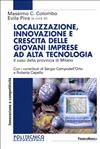
As the world economy battles a global crisis of historical breadth and depth, NTBFs (new technology-based firms) are navigating in rough seas. In fact, the radical changes in the competitive arena triggered by the crisis are prompting NTBFs to change their strategies in order to reorient resources and capabilities. The paper adopts the dynamic capabilities perspective to shed light on two research questions: (i) What is the impact on the growth of an NTBF of its dynamic capability to reorient the firm’s strategies to deal with the crisis? and (ii) What are the precursors of this dynamic capability? The paper develops and tests a set of hypotheses using a unique dataset of Italian NTBFs. The econometric results of our analysis show that such dynamic capabilities have a positive effect on NTBF growth and, moreover, that these are positively correlated with the industry-specific technical work experience of the founders of the NTBFs, the NTBFs’ presence as insiders in the international markets, their forging of technological alliances, and their limited resources.


